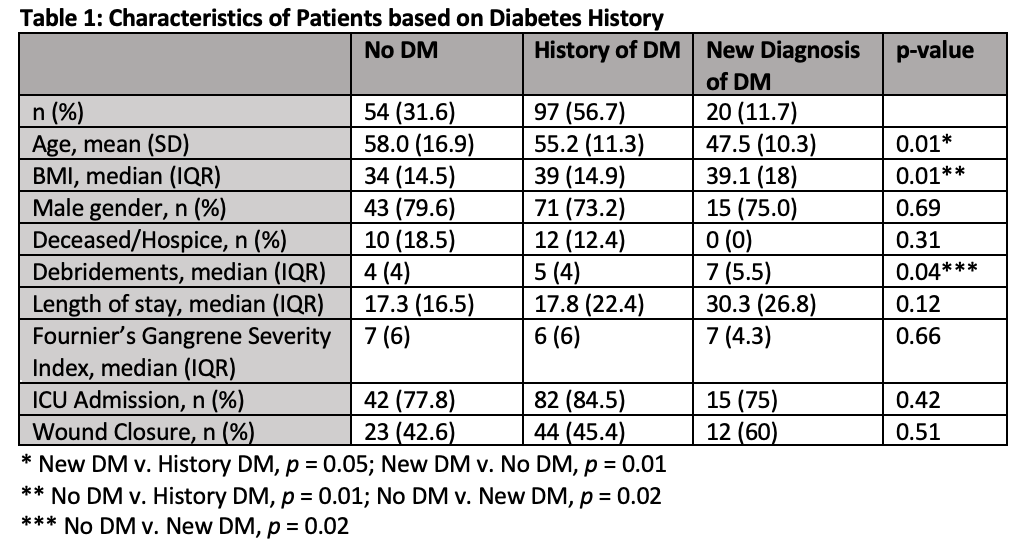Back
Poster, Podium & Video Sessions
Moderated Poster
MP37: Infections/Inflammation/Cystic Disease of the Genitourinary Tract: Prostate & Genitalia
MP37-19: Rate and Prognostic Value of New Diagnoses of Diabetes with Fournier's Gangrene
Sunday, May 15, 2022
7:00 AM – 8:15 AM
Location: Room 225
Christopher Staniorski*, Michael Pintauro, Emily Hacker, Jen Mihalo, Benjamin Davies, Bruce Jacobs, Michelle Yu, Paul Rusilko, Pittsburgh, PA

Christopher John Staniorski, MD
University of Pittsburgh Medical Center
Poster Presenter(s)
Introduction: In Fournier’s Gangrene (FG) patients, issues with glycemic control are well described with up to 56% of FG cases having diabetes mellitus (DM). Poorly controlled DM may lead to more severe FG presentations, but prior reports have shown conflicting evidence. There is no prior report of rate or outcomes of new diagnosis of DM on presentation for FG. Our aim is to analyze outcomes of patients with a new diagnosis of diabetes on FG presentation.
Methods: A retrospective review of the electronic medical record identified 171 cases of FG by CPT diagnosis code admitted or transferred to a tertiary care hospital in a major city from 2010-2020. Charts were abstracted for elements of medical history, presentation and outcomes.
Results: Rates of pre-existing DM were comparable to prior reports at 56.7%. Of patients presenting without an established diagnosis of DM, 27% were newly diagnosed with DM on presentation. A history of DM was not associated with worse outcomes. Patients newly diagnosed with DM on presentation were younger (p = 0.01) with a higher BMI (p = 0.01). While mortality was similar, the patients with newly diagnosed DM had more severe clinical course as they underwent significantly more debridements than those without DM (7 v. 4, p = 0.04). Hemoglobin A1c was measured in only 57% of patients during their hospitalization, with younger patients with higher BMI more often having A1c recorded (p = 0.01). Multivariate analysis showed a younger age (OR 0.97, CI 0.94-0.99) and wound closure (OR 1.9, CI 1.01- 3.81) as predictors of hemoglobin A1c measurement.
Conclusions: New diagnosis of DM on presentation with FG occurs in 27% of patients. While history of DM diagnosis is not associated with worsening outcomes, patients with newly diagnosed DM on presentation undergo more debridements despite younger age at presentation. This suggests that untreated glucose intolerance may worsen natural history of disease. Despite the known association with DM, just over half of FG patients have hemoglobin A1c measured during hospitalization, leaving opportunity for medical screening in addition to surgical management. Further studies are required to establish if tighter glucose control in the hospital would lead to better clinical outcomes.
Source of Funding: None

Methods: A retrospective review of the electronic medical record identified 171 cases of FG by CPT diagnosis code admitted or transferred to a tertiary care hospital in a major city from 2010-2020. Charts were abstracted for elements of medical history, presentation and outcomes.
Results: Rates of pre-existing DM were comparable to prior reports at 56.7%. Of patients presenting without an established diagnosis of DM, 27% were newly diagnosed with DM on presentation. A history of DM was not associated with worse outcomes. Patients newly diagnosed with DM on presentation were younger (p = 0.01) with a higher BMI (p = 0.01). While mortality was similar, the patients with newly diagnosed DM had more severe clinical course as they underwent significantly more debridements than those without DM (7 v. 4, p = 0.04). Hemoglobin A1c was measured in only 57% of patients during their hospitalization, with younger patients with higher BMI more often having A1c recorded (p = 0.01). Multivariate analysis showed a younger age (OR 0.97, CI 0.94-0.99) and wound closure (OR 1.9, CI 1.01- 3.81) as predictors of hemoglobin A1c measurement.
Conclusions: New diagnosis of DM on presentation with FG occurs in 27% of patients. While history of DM diagnosis is not associated with worsening outcomes, patients with newly diagnosed DM on presentation undergo more debridements despite younger age at presentation. This suggests that untreated glucose intolerance may worsen natural history of disease. Despite the known association with DM, just over half of FG patients have hemoglobin A1c measured during hospitalization, leaving opportunity for medical screening in addition to surgical management. Further studies are required to establish if tighter glucose control in the hospital would lead to better clinical outcomes.
Source of Funding: None


.jpg)
.jpg)